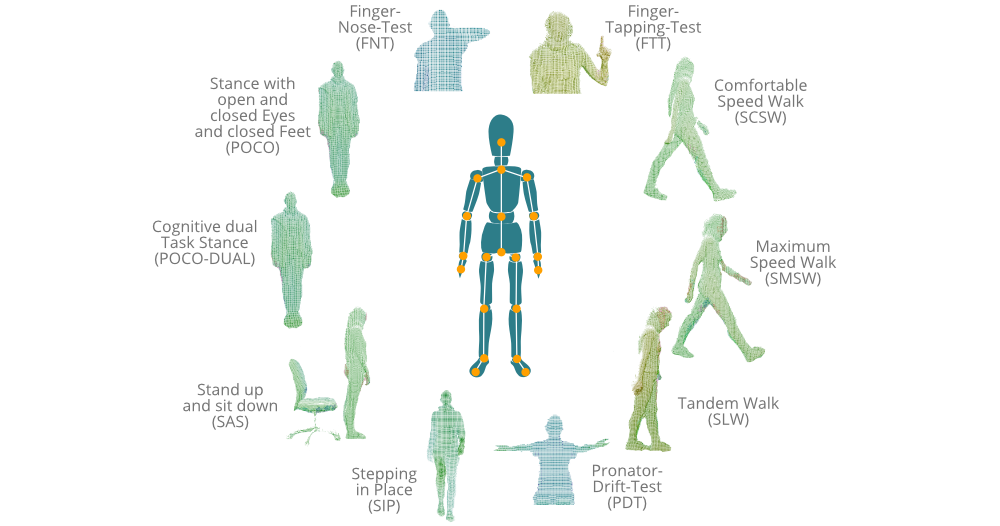
3D Cameras

We work with sensors that scan their environment three-dimensionally using infrared light analysis and are able to accurately measure shapes and movements in the space in front of them. With such commercially available 3D cameras, body parts can be tracked with an accuracy in the millimeter range - without requiring the user to wear any markers or special clothing.
What we measure
For each motor task, specific kinematic outcome parameters were developed to describe motor behavior and symptoms. These parameters are in metrical units and therefore easily interpreted by a trained professional. We additionally provide analysis modules that use computer vision approaches to generate and aggregate visualizations of depth videos, such as motion profiles. This can be used for validation of recordings or exploratory evaluation of movement patterns.

For each motor task, kinematic parameters are extracted describing different motor symptoms.
-
BALANCE
-
GAIT
-
STEPPING IN PLACE
Accurate, Reliable and Validated
All our kinematic outcomes are clinically and technically validated against gold standard methods and provide a high reliability. For each parameter, individual accuracy levels are given to understand where and when to use them. Our outcomes are evaluated and used in clinical studies, published in peer-reviewed journals and presented at international congresses since 2014.
Publications
Peer reviewed papers:
- Steinert, A.; Sattler, I.; Otte, K.; Röhling, H.; Mansow-Model, S.; Müller-Werdan, U. Using New Camera-Based Technologies for Gait Analysis in Older Adults in Comparison to the Established GAITRite System. Sensors 2020, 20, 125. [PubMed] [DOI]
- Kroneberg D, Elshehabi M, Meyer A-C, Otte K, Doss S, Paul F, Nussbaum S, Berg D, Kühn AA, Maetzler W and Schmitz-Hübsch T (2019) Less Is More – Estimation of the Number of Strides Required to Assess Gait Variability in Spatially Confined Settings. Front. Aging Neurosci. 10:435. [PubMed] [DOI]
Conference posters and talks:
- Otte, Karen; Röhling, Hanna; Rasche, Ludwig; Ellermeyer, Tobias; Mansow-Model, Sebastian; Paul, Friedemann; Brandt, Alexander U; Lipp, Axel; Schmitz-Hübsch, Tanja; 2019. Quantitative analysis of MDS-UPDRS III finger tapping and hand grip test using visual perceptive computing.
- Otte, K., Heinrich, F., Ellermeyer, T., Kayser, B., Mansow-Model, S., Paul, F., Brandt, A.U., Skowronek, C., Lipp, A., Schmitz-Hübsch, T., 2018. Evaluation of visual perceptive computing for Tremor Analysis. Mov Disord. 33 (suppl 2), 1.